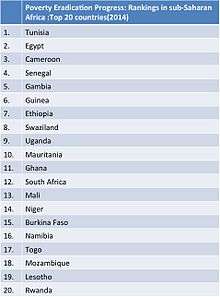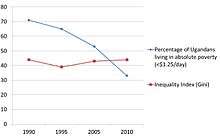Poverty in Uganda
Extreme poverty is defined as living on less than 2.50 United States dollars (USD) purchasing power parity. Uganda has made significant progress in eradicating poverty and achieved the first millennium development goal of halving the number of people in extreme poverty.[1] Uganda was listed as the 9th most successful country in Africa as regards poverty eradication[2] as shown in figure 1. All but one country above it have access to the coast, a significant economic advantage. The trend in poverty eradication is shown in figure 2 and the finance ministry in the country projected that the extreme poverty level will have reduced to 10%.[1] This success has been attributed to the deliberate efforts to combat poverty in the country by numerous national strategies that are explained below.

Education
Lack of education in sub-Saharan Africa is a major determinant of extreme poverty. Uganda has made some progress in fighting illiteracy with current literacy levels at 76%.[1] Education is funded both by private means and by the government. With free primary and secondary education through the universal primary and secondary education over 90% of the population attains a primary education, however the quality of education being offered is low according to a survey done by the world bank in the country in 2013[3]
Progress

Uganda has made progress towards poverty elimination having successfully achieved the millennium development goal target of halving the number of people in extreme poverty way ahead of the 2015 deadline. Today, an estimated 25% still live in extreme poverty but Uganda is on course to achieve its national target of reducing this number to 10% by 2017[4] Despite this progress, significant inequality still exists and the civil society parallel report on the progress made by the country highlights the possibility of the above official figures to have been exaggerated[5]
The world’s reduction of extreme poverty from 47% of the entire population in 1990 to 14% of the entire population has shown the possibility of eradicating extreme poverty from the world in the next generation.[6] With a 28% reduction, Sub-Saharan African region showed the least improvement in poverty eradication in the period from 1990 to 2015 compared to the other regions. Uganda has deferred from the general sub-Saharan trend by significantly reducing the proportion of the extremely poor to 25%.
National development Plan 1 (NDP 1)
This was a strategy initiated in 2010/11 to eradicate poverty in Uganda.It replaced the Poverty Eradication Action plan(PEAP). The NDP 1 focused on primary growth sectors that provide direct products and services and these include Agriculture, tourism, oil and gas, manufacturing, forestry, mining and ICT. Secondly, it focused on complementary sector which provides infrastructural support to the products;these include transport, energy and water, trade and financial services [7]
National development plan II (NDP II)
In June 2015, the government of Uganda and United Nations Developmental Assistance launched the NDP II to guide Uganda's path to poverty eradication. The main goal of the NDP II is to propel Uganda to the middle-income status with a GDP per capita of USD 1,003.[8]
NDPII aims
To strengthen the country‘s competitiveness for sustainable wealth creation, employment and inclusive growth through Increasing sustainable production, productivity and value addition in key growth opportunities Increasing the stock and quality of strategic infrastructure to accelerate the country‘s competitiveness Enhancing human capital development Strengthening mechanisms for quality, effective and efficient service delivery.[9]
Goals of NDP II by 2020
- To increase income from USD 788 to USD 1,033
- To reduce the poverty rate from 19.7% to 14.2%
- To reduce the number of young people not in education,employment or training by at least 50%
- To increase manufactured exports as a percentage of total exports from 5.8% to 19%
- To increase percentage of population with access to electricity from 14% to 30%
- To increase access to safe water from 65% to 79% in rural and from 77% to 100% in Urban areas.
- To increasing the quantity of total national paved road network(km) from 3,795 to 5,000
- To reduce the infant mortality rate per 1,000 from 54 to 44 and maternal mortality per 100,000 from 438 to 220,000
- To reduce fertility to 4.5 children per woman
- To increase primary to secondary transition rate from 73% to 80% and net secondary completion rate from 36% to 50%
Main economic focus
Agriculture is Uganda's main economic activity. Twelve key agricultural products have been ear marked for investment: cotton, coffee, tea, maize, rice, cassava, beans, fish, beef, milk, citrus and bananas. Uganda is commonly referred to as the pearl of Africa because of its natural beauty. This often attracts tourists from all over the world. Improvement, diversification and aggressive marketing of the tourism sector has thence been highlighted in the second national development plan. The country will focus on the exploitation of iron ore, limestone ad marble, copper, cobalt, phosphates, dimension stones and uranium. In addition, the country's newly discovered 6.5 billion barrels of oil are to be exploited.
Challenges
Inequality between the rich and power at various levels of the society remains a challenge, as is shown by the high inequality index as measured by the Gini, currently over 40%. Challenges highlighted by the first national development plan [10] continue to exist. These include slow growth in agricultural and industrial sector, low productivity growth in agriculture, poor mediation of capital by capital markets and the primary dominance of primary over industrial products.
References
- 1 2 3 United Nations Development Programme. "The Uganda 2013 Millennium Development Goals progress Report".
- ↑ United Nations Economic Commission for Africa. "MDG 2014 Report" (PDF).
- ↑ Wold bank. "Quality of Uganda's education and Health services poses serious risk to long term economic progress".
- ↑ United Nations Development Fund. "Uganda MDG report 2013" (PDF).
- ↑ 2013 common wealth foundation. "National report : Uganda" (PDF).
- ↑ United Nations. "The Millennium Development goals report 2015" (PDF).
- ↑ International Monetary Fund. "National Development Plan(2010/11-2014/15)" (PDF).
- ↑ Republic of uganda. "Second National Development Plan 2015/16-2019/20(NDPII)" (PDF).
- ↑ United Nations. "UNDAF Uganda,2016-2020" (PDF).
- ↑ International Monetary Fund. "Uganda: Poverty Reduction Strategy Paper" (PDF).